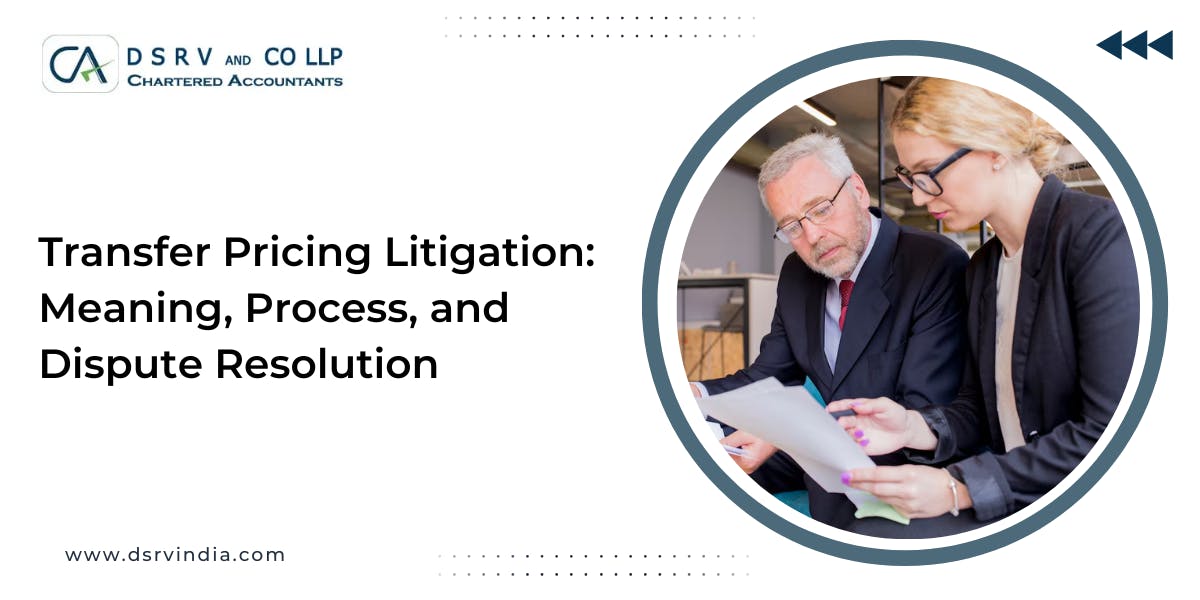Transfer Pricing Litigation: Meaning, Process, and Dispute Resolution
Transfer pricing litigation means, why disputes arise, how the process works in India, and how a CA firm can help you navigate assessments, DRP hearings, and appeals effectively.
Transfer pricing litigation means, why disputes arise, how the process works in India, and how a CA firm can help you navigate assessments, DRP hearings, and appeals effectively.

Transfer pricing is one of those terms that often makes business owners especially multinational companies sit up straight. In simple words, transfer pricing refers to the price charged for transactions between related entities in different countries for example, when a company’s Indian subsidiary buys or sells goods or services to its parent or sister company abroad.
While these are normal business transactions, tax authorities in India often scrutinize them closely. They want to ensure that the prices reflect “arm’s length” meaning, what independent parties would have charged under similar circumstances. When the prices deviate from this standard, the Transfer Pricing Officer (TPO) may challenge them, leading to transfer pricing litigation.
Over the years, this has become one of the most complex and heavily contested areas of tax law in India. Disputes can run into crores and often take years to resolve. That’s why businesses increasingly rely on professional advisors and chartered accountant firms in Gurgaon to manage these matters smoothly.
At DSRV India, our tax experts assist clients in handling transfer pricing disputes strategically reducing exposure, managing documentation, and representing them at every stage of litigation.

In simple terms, transfer pricing litigation begins when the Transfer Pricing Officer (TPO) disagrees with the pricing or documentation submitted by a taxpayer during assessment.
Under Section 92CA of the Income Tax Act, the TPO has the authority to assess whether the transactions between related parties are at arm’s length. If they believe that the pricing is not justified, they propose an adjustment meaning they increase the taxable income.
This adjustment is reflected in the Draft Assessment Order (DAO) issued by the Assessing Officer (AO). From there, the taxpayer can challenge the findings through the Dispute Resolution Panel (DRP), and if necessary, the Income Tax Appellate Tribunal (ITAT), and even the High Court or Supreme Court.
In short, transfer pricing litigation is the dispute resolution process that unfolds between taxpayers and the tax authorities over international transactions and their valuation.
Read More: WHY TRANSFER PRICING IS IMPORTANT & TP REPORT FILING DUE DATE
Transfer pricing litigation doesn’t happen overnight. It usually stems from one or more of the following reasons:
For example, an Indian subsidiary paying a 5% royalty to its U.S. parent might face litigation if the tax officer believes the value should have been lower. Such cases are now routine in India’s transfer pricing landscape.

Also Read: Most Common Errors In TP Study Reports In India
Let’s look at how the litigation process unfolds once a transfer pricing issue is flagged.
The process starts with a transfer pricing audit by the Transfer Pricing Officer (TPO) under Section 92CA.
If the TPO finds inconsistencies or believes that the pricing is not at arm’s length, they propose an adjustment.
After receiving directions from the DRP, the AO passes the Final Assessment Order, along with a demand notice for any additional tax payable.
If the taxpayer is not satisfied with ITAT’s order, further appeals can be filed:
High Court – for substantial legal questions
Supreme Court – final stage for cases of national importance
Each stage involves detailed documentation, legal drafting, and expert representation, this is where an experienced GST consultant in Gurgaon or tax litigation team becomes invaluable.
Successfully handling transfer pricing disputes requires preparation and strategy. Here are key steps:
At DSRV India, our CA in Gurgaon team provides expert representation at every stage — from the transfer pricing audit to the Income Tax Appellate Tribunal (ITAT), ensuring your case is presented strategically and backed by facts.

Litigation isn’t always the only path. The Indian tax system also provides several mechanisms for resolving transfer pricing disputes without prolonged court battles.
These mechanisms save time, money, and stress — and are particularly useful for multinational companies with recurring intercompany transactions.
Transfer pricing disputes can be avoided or at least minimized with proactive measures:
Most importantly, never treat documentation as a “tick-box exercise.” The more effort you put into building a strong compliance file, the lower your risk of litigation.
Transfer pricing is a blend of law, economics, and business strategy and handling it requires expertise across all three. This is where a chartered accountant firm in Gurgaon can make a real difference.
A professional CA team helps by:
Having a professional advisor by your side ensures that your case is not just compliant but also strategically defended with solid data and reasoning.

Preparation is half the battle won. Before a transfer pricing audit begins, make sure your documentation and processes are airtight.
Here’s a quick checklist:
A proactive internal review preferably conducted with a GST and international tax consultant in Gurgaon can help identify gaps before they become audit findings.
Many taxpayers end up in litigation due to avoidable errors. Here are the common pitfalls:
Avoiding these mistakes keeps you ahead of potential challenges and helps build credibility with tax officers.

Transfer pricing litigation is a complex but manageable part of doing business globally. It’s not just about defending numbers it’s about telling your business story in a way that aligns with law, economics, and intent.
With global transactions under constant scrutiny, tax authorities are becoming more analytical and data-driven. But so can you by maintaining strong documentation, adopting the right methodologies, and engaging experts early on.
If you face a dispute, remember that it’s not the end of the road. With the right strategy, most transfer pricing cases can be resolved efficiently, even before reaching higher tribunals.
At DSRV India, our international tax and transfer pricing specialists provide practical, end-to-end support from TPO assessments to ITAT representation. We combine technical expertise with real-world insight to protect your interests and ensure compliance with Indian and global tax laws.
Facing GST registration rejection? Discover rejection reasons and resolve GST registration issues. Ensure a smooth application process in 2026.
Dispute Resolution Panel (DRP) in Income Tax: Learn about alternative dispute resolution mechanism for income tax disputes and transfer pricing litigation.
Build a strong transfer pricing defense file. Ensure compliance and avoid tax disputes with crucial transfer pricing documentation and audit readiness.
